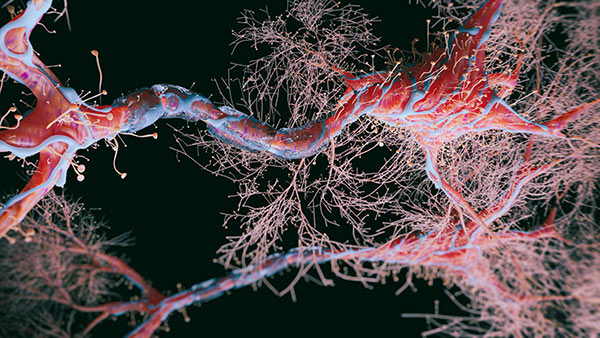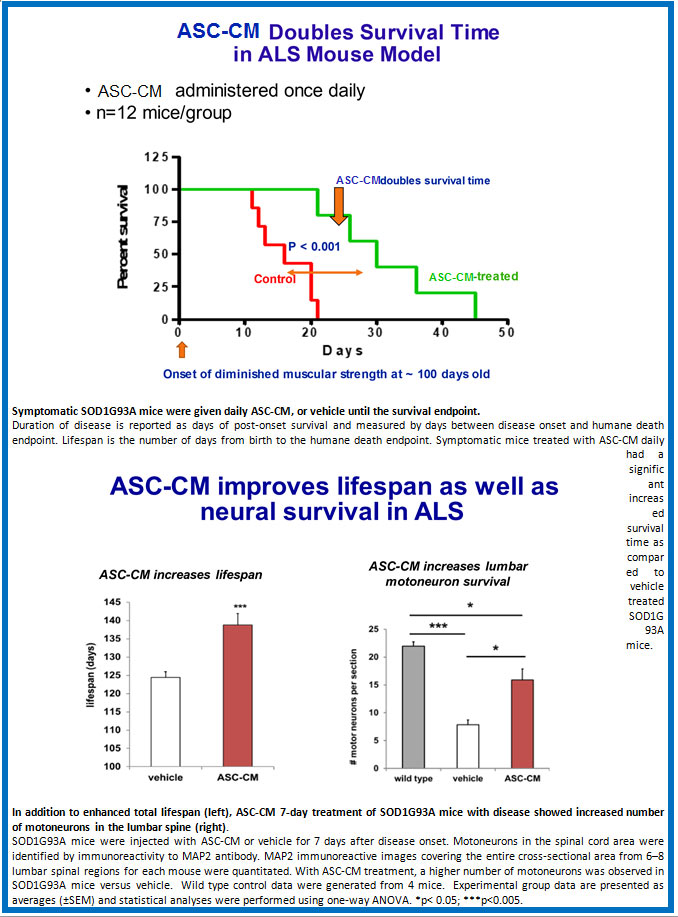ALS
 Background
Background
Amyotrophic lateral sclerosis (ALS), also known as Lou Gehrig’s disease, is a neurogenerative disease that results in the loss of motor neurons that control voluntary muscles. As the disease progresses, it will result in the loss of speech, movement and finally the ability to breathe and subsequent death.
ALS currently has no cure, and available treatments aim to alleviate symptoms, slow disease progression, and improve quality of life. However, the limitations of existing treatments highlight the urgent need for more effective therapeutic options. Current treatments, such as riluzole and edaravone, provide only modest benefits and do not halt or reverse the underlying neurodegeneration.
Neuron pathology at the cellular level includes glutamate excitotoxicity, glial cell activation, oxidative damage, neuroinflammation, aberrant protein folding, mitochondrial dysfunction, and axonal transport. Addressing these underlying mechanisms and promoting neuroprotection, neuroregeneration, and functional recovery are critical in developing novel therapeutic approaches for ALS.
ALS affects between 12,000-20,000 people in the United States, with about 5,000 new cases diagnosed each year. Accordingly, ALS is a disease eligible for orphan designation.
The economic burden of ALS includes direct medical costs such as hospitalization, medication, assistive devices, and home care. Additionally, the indirect costs associated with long-term care needs, lost productivity, and the impact on caregivers contribute to the overall financial burden. The lifetime cost of care for an individual with ALS is estimated to be in the range of $1.5 to $2.5 million. (Source: ALS Association)
The Theratome Solution
Because multiple signaling pathways are associated with this disease, an effective multi-targeted approach may be required to treat ALS. Secretomes contain a multitude of neuroprotective and neurotrophic factors, such as brain-derived neurotropic factor (BDNF), nerve growth factor (NGF), vascular endothelial growth factor (VEGF), hepatocyte growth factor (HGF) and insulin-like growth factors.
In two independent studies of mice with the mutation in SOD1 that mimics a prevalent single mutation responsible for ALS in human, repeated Secretome administration initiated at the time of symptom onset significantly extended survival and lifespan, approximately doubling the survival following the initial presentation of disease. In concert with this remarkable survival advantage, treated mice showed an increase in number of motor neurons present in the lumbar spine.

Because of the multitude of synergistic neurotrophic factors, Thera-101 is able to block or modify several neuronal death pathways.
Competition
Although current products are on the market to treat ALS, they are not curative and only slightly extend the lifespan of patients. Secretomes have the potential to be much more effective, and may synergize with existing treatments.
These products include riluzole (introduced in 1995 and now off patent), edaravone (approved in 2017) and a combination product approved in 2022 (sodium phenyl butyrate + taurursodiol). There are a number of new products under development including immunotherapy.
